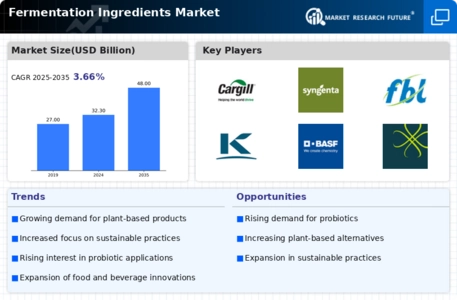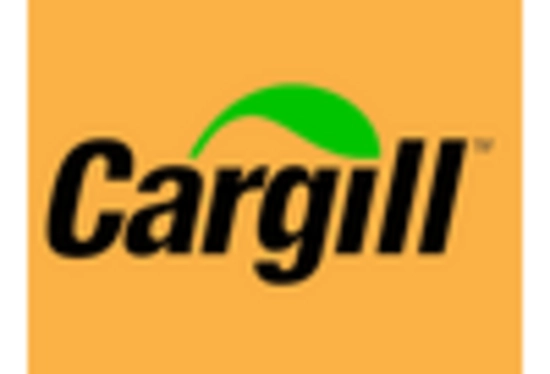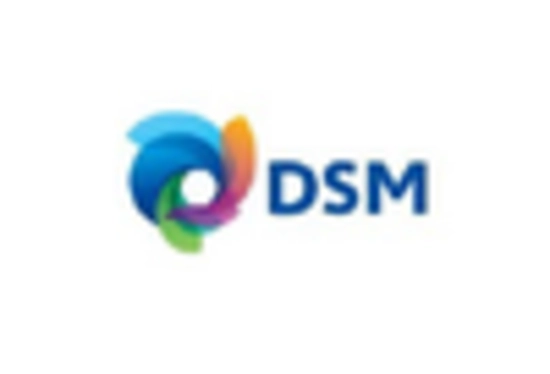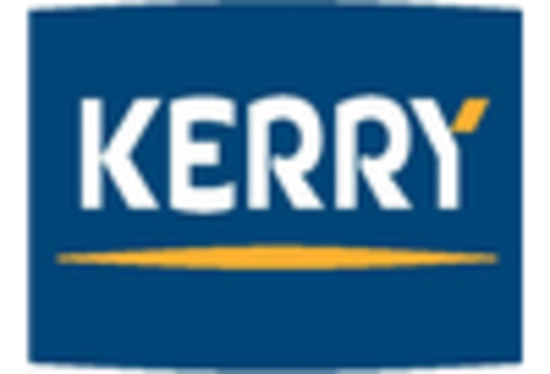- Fermentation Ingredients Market By Application (USD Billion, 2019-2035)
- Food Beverages
- Pharmaceuticals
- Animal Feed
- Biofuels
- Fermentation Ingredients Market By Type (USD Billion, 2019-2035)
- Yeast
- Bacterial Cultures
- Enzymes
- Acids
- Fermentation Ingredients Market By Source (USD Billion, 2019-2035)
- Fermentation Ingredients Market By Form (USD Billion, 2019-2035)
- Fermentation Ingredients Market By Regional (USD Billion, 2019-2035)
- North America
- Europe
- South America
- Asia Pacific
- Middle East and Africa
North America Outlook (USD Billion, 2019-2035)
North America Fermentation Ingredients Market by Application Type
Food Beverages
Pharmaceuticals
Animal Feed
Biofuels
North America Fermentation Ingredients Market by Type
Yeast
Bacterial Cultures
Enzymes
Acids
North America Fermentation Ingredients Market by Source Type
Natural
Synthetic
North America Fermentation Ingredients Market by Form Type
Liquid
Powder
Granular
North America Fermentation Ingredients Market by Regional Type
US
Canada
US Outlook (USD Billion, 2019-2035)
US Fermentation Ingredients Market by Application Type
Food Beverages
Pharmaceuticals
Animal Feed
Biofuels
US Fermentation Ingredients Market by Type
Yeast
Bacterial Cultures
Enzymes
Acids
US Fermentation Ingredients Market by Source Type
Natural
Synthetic
US Fermentation Ingredients Market by Form Type
Liquid
Powder
Granular
CANADA Outlook (USD Billion, 2019-2035)
CANADA Fermentation Ingredients Market by Application Type
Food Beverages
Pharmaceuticals
Animal Feed
Biofuels
CANADA Fermentation Ingredients Market by Type
Yeast
Bacterial Cultures
Enzymes
Acids
CANADA Fermentation Ingredients Market by Source Type
Natural
Synthetic
CANADA Fermentation Ingredients Market by Form Type
Liquid
Powder
Granular
Europe Outlook (USD Billion, 2019-2035)
Europe Fermentation Ingredients Market by Application Type
Food Beverages
Pharmaceuticals
Animal Feed
Biofuels
Europe Fermentation Ingredients Market by Type
Yeast
Bacterial Cultures
Enzymes
Acids
Europe Fermentation Ingredients Market by Source Type
Natural
Synthetic
Europe Fermentation Ingredients Market by Form Type
Liquid
Powder
Granular
Europe Fermentation Ingredients Market by Regional Type
Germany
UK
France
Russia
Italy
Spain
Rest of Europe
GERMANY Outlook (USD Billion, 2019-2035)
GERMANY Fermentation Ingredients Market by Application Type
Food Beverages
Pharmaceuticals
Animal Feed
Biofuels
GERMANY Fermentation Ingredients Market by Type
Yeast
Bacterial Cultures
Enzymes
Acids
GERMANY Fermentation Ingredients Market by Source Type
Natural
Synthetic
GERMANY Fermentation Ingredients Market by Form Type
Liquid
Powder
Granular
UK Outlook (USD Billion, 2019-2035)
UK Fermentation Ingredients Market by Application Type
Food Beverages
Pharmaceuticals
Animal Feed
Biofuels
UK Fermentation Ingredients Market by Type
Yeast
Bacterial Cultures
Enzymes
Acids
UK Fermentation Ingredients Market by Source Type
Natural
Synthetic
UK Fermentation Ingredients Market by Form Type
Liquid
Powder
Granular
FRANCE Outlook (USD Billion, 2019-2035)
FRANCE Fermentation Ingredients Market by Application Type
Food Beverages
Pharmaceuticals
Animal Feed
Biofuels
FRANCE Fermentation Ingredients Market by Type
Yeast
Bacterial Cultures
Enzymes
Acids
FRANCE Fermentation Ingredients Market by Source Type
Natural
Synthetic
FRANCE Fermentation Ingredients Market by Form Type
Liquid
Powder
Granular
RUSSIA Outlook (USD Billion, 2019-2035)
RUSSIA Fermentation Ingredients Market by Application Type
Food Beverages
Pharmaceuticals
Animal Feed
Biofuels
RUSSIA Fermentation Ingredients Market by Type
Yeast
Bacterial Cultures
Enzymes
Acids
RUSSIA Fermentation Ingredients Market by Source Type
Natural
Synthetic
RUSSIA Fermentation Ingredients Market by Form Type
Liquid
Powder
Granular
ITALY Outlook (USD Billion, 2019-2035)
ITALY Fermentation Ingredients Market by Application Type
Food Beverages
Pharmaceuticals
Animal Feed
Biofuels
ITALY Fermentation Ingredients Market by Type
Yeast
Bacterial Cultures
Enzymes
Acids
ITALY Fermentation Ingredients Market by Source Type
Natural
Synthetic
ITALY Fermentation Ingredients Market by Form Type
Liquid
Powder
Granular
SPAIN Outlook (USD Billion, 2019-2035)
SPAIN Fermentation Ingredients Market by Application Type
Food Beverages
Pharmaceuticals
Animal Feed
Biofuels
SPAIN Fermentation Ingredients Market by Type
Yeast
Bacterial Cultures
Enzymes
Acids
SPAIN Fermentation Ingredients Market by Source Type
Natural
Synthetic
SPAIN Fermentation Ingredients Market by Form Type
Liquid
Powder
Granular
REST OF EUROPE Outlook (USD Billion, 2019-2035)
REST OF EUROPE Fermentation Ingredients Market by Application Type
Food Beverages
Pharmaceuticals
Animal Feed
Biofuels
REST OF EUROPE Fermentation Ingredients Market by Type
Yeast
Bacterial Cultures
Enzymes
Acids
REST OF EUROPE Fermentation Ingredients Market by Source Type
Natural
Synthetic
REST OF EUROPE Fermentation Ingredients Market by Form Type
Liquid
Powder
Granular
APAC Outlook (USD Billion, 2019-2035)
APAC Fermentation Ingredients Market by Application Type
Food Beverages
Pharmaceuticals
Animal Feed
Biofuels
APAC Fermentation Ingredients Market by Type
Yeast
Bacterial Cultures
Enzymes
Acids
APAC Fermentation Ingredients Market by Source Type
Natural
Synthetic
APAC Fermentation Ingredients Market by Form Type
Liquid
Powder
Granular
APAC Fermentation Ingredients Market by Regional Type
China
India
Japan
South Korea
Malaysia
Thailand
Indonesia
Rest of APAC
CHINA Outlook (USD Billion, 2019-2035)
CHINA Fermentation Ingredients Market by Application Type
Food Beverages
Pharmaceuticals
Animal Feed
Biofuels
CHINA Fermentation Ingredients Market by Type
Yeast
Bacterial Cultures
Enzymes
Acids
CHINA Fermentation Ingredients Market by Source Type
Natural
Synthetic
CHINA Fermentation Ingredients Market by Form Type
Liquid
Powder
Granular
INDIA Outlook (USD Billion, 2019-2035)
INDIA Fermentation Ingredients Market by Application Type
Food Beverages
Pharmaceuticals
Animal Feed
Biofuels
INDIA Fermentation Ingredients Market by Type
Yeast
Bacterial Cultures
Enzymes
Acids
INDIA Fermentation Ingredients Market by Source Type
Natural
Synthetic
INDIA Fermentation Ingredients Market by Form Type
Liquid
Powder
Granular
JAPAN Outlook (USD Billion, 2019-2035)
JAPAN Fermentation Ingredients Market by Application Type
Food Beverages
Pharmaceuticals
Animal Feed
Biofuels
JAPAN Fermentation Ingredients Market by Type
Yeast
Bacterial Cultures
Enzymes
Acids
JAPAN Fermentation Ingredients Market by Source Type
Natural
Synthetic
JAPAN Fermentation Ingredients Market by Form Type
Liquid
Powder
Granular
SOUTH KOREA Outlook (USD Billion, 2019-2035)
SOUTH KOREA Fermentation Ingredients Market by Application Type
Food Beverages
Pharmaceuticals
Animal Feed
Biofuels
SOUTH KOREA Fermentation Ingredients Market by Type
Yeast
Bacterial Cultures
Enzymes
Acids
SOUTH KOREA Fermentation Ingredients Market by Source Type
Natural
Synthetic
SOUTH KOREA Fermentation Ingredients Market by Form Type
Liquid
Powder
Granular
MALAYSIA Outlook (USD Billion, 2019-2035)
MALAYSIA Fermentation Ingredients Market by Application Type
Food Beverages
Pharmaceuticals
Animal Feed
Biofuels
MALAYSIA Fermentation Ingredients Market by Type
Yeast
Bacterial Cultures
Enzymes
Acids
MALAYSIA Fermentation Ingredients Market by Source Type
Natural
Synthetic
MALAYSIA Fermentation Ingredients Market by Form Type
Liquid
Powder
Granular
THAILAND Outlook (USD Billion, 2019-2035)
THAILAND Fermentation Ingredients Market by Application Type
Food Beverages
Pharmaceuticals
Animal Feed
Biofuels
THAILAND Fermentation Ingredients Market by Type
Yeast
Bacterial Cultures
Enzymes
Acids
THAILAND Fermentation Ingredients Market by Source Type
Natural
Synthetic
THAILAND Fermentation Ingredients Market by Form Type
Liquid
Powder
Granular
INDONESIA Outlook (USD Billion, 2019-2035)
INDONESIA Fermentation Ingredients Market by Application Type
Food Beverages
Pharmaceuticals
Animal Feed
Biofuels
INDONESIA Fermentation Ingredients Market by Type
Yeast
Bacterial Cultures
Enzymes
Acids
INDONESIA Fermentation Ingredients Market by Source Type
Natural
Synthetic
INDONESIA Fermentation Ingredients Market by Form Type
Liquid
Powder
Granular
REST OF APAC Outlook (USD Billion, 2019-2035)
REST OF APAC Fermentation Ingredients Market by Application Type
Food Beverages
Pharmaceuticals
Animal Feed
Biofuels
REST OF APAC Fermentation Ingredients Market by Type
Yeast
Bacterial Cultures
Enzymes
Acids
REST OF APAC Fermentation Ingredients Market by Source Type
Natural
Synthetic
REST OF APAC Fermentation Ingredients Market by Form Type
Liquid
Powder
Granular
South America Outlook (USD Billion, 2019-2035)
South America Fermentation Ingredients Market by Application Type
Food Beverages
Pharmaceuticals
Animal Feed
Biofuels
South America Fermentation Ingredients Market by Type
Yeast
Bacterial Cultures
Enzymes
Acids
South America Fermentation Ingredients Market by Source Type
Natural
Synthetic
South America Fermentation Ingredients Market by Form Type
Liquid
Powder
Granular
South America Fermentation Ingredients Market by Regional Type
Brazil
Mexico
Argentina
Rest of South America
BRAZIL Outlook (USD Billion, 2019-2035)
BRAZIL Fermentation Ingredients Market by Application Type
Food Beverages
Pharmaceuticals
Animal Feed
Biofuels
BRAZIL Fermentation Ingredients Market by Type
Yeast
Bacterial Cultures
Enzymes
Acids
BRAZIL Fermentation Ingredients Market by Source Type
Natural
Synthetic
BRAZIL Fermentation Ingredients Market by Form Type
Liquid
Powder
Granular
MEXICO Outlook (USD Billion, 2019-2035)
MEXICO Fermentation Ingredients Market by Application Type
Food Beverages
Pharmaceuticals
Animal Feed
Biofuels
MEXICO Fermentation Ingredients Market by Type
Yeast
Bacterial Cultures
Enzymes
Acids
MEXICO Fermentation Ingredients Market by Source Type
Natural
Synthetic
MEXICO Fermentation Ingredients Market by Form Type
Liquid
Powder
Granular
ARGENTINA Outlook (USD Billion, 2019-2035)
ARGENTINA Fermentation Ingredients Market by Application Type
Food Beverages
Pharmaceuticals
Animal Feed
Biofuels
ARGENTINA Fermentation Ingredients Market by Type
Yeast
Bacterial Cultures
Enzymes
Acids
ARGENTINA Fermentation Ingredients Market by Source Type
Natural
Synthetic
ARGENTINA Fermentation Ingredients Market by Form Type
Liquid
Powder
Granular
REST OF SOUTH AMERICA Outlook (USD Billion, 2019-2035)
REST OF SOUTH AMERICA Fermentation Ingredients Market by Application Type
Food Beverages
Pharmaceuticals
Animal Feed
Biofuels
REST OF SOUTH AMERICA Fermentation Ingredients Market by Type
Yeast
Bacterial Cultures
Enzymes
Acids
REST OF SOUTH AMERICA Fermentation Ingredients Market by Source Type
Natural
Synthetic
REST OF SOUTH AMERICA Fermentation Ingredients Market by Form Type
Liquid
Powder
Granular
MEA Outlook (USD Billion, 2019-2035)
MEA Fermentation Ingredients Market by Application Type
Food Beverages
Pharmaceuticals
Animal Feed
Biofuels
MEA Fermentation Ingredients Market by Type
Yeast
Bacterial Cultures
Enzymes
Acids
MEA Fermentation Ingredients Market by Source Type
Natural
Synthetic
MEA Fermentation Ingredients Market by Form Type
Liquid
Powder
Granular
MEA Fermentation Ingredients Market by Regional Type
GCC Countries
South Africa
Rest of MEA
GCC COUNTRIES Outlook (USD Billion, 2019-2035)
GCC COUNTRIES Fermentation Ingredients Market by Application Type
Food Beverages
Pharmaceuticals
Animal Feed
Biofuels
GCC COUNTRIES Fermentation Ingredients Market by Type
Yeast
Bacterial Cultures
Enzymes
Acids
GCC COUNTRIES Fermentation Ingredients Market by Source Type
Natural
Synthetic
GCC COUNTRIES Fermentation Ingredients Market by Form Type
Liquid
Powder
Granular
SOUTH AFRICA Outlook (USD Billion, 2019-2035)
SOUTH AFRICA Fermentation Ingredients Market by Application Type
Food Beverages
Pharmaceuticals
Animal Feed
Biofuels
SOUTH AFRICA Fermentation Ingredients Market by Type
Yeast
Bacterial Cultures
Enzymes
Acids
SOUTH AFRICA Fermentation Ingredients Market by Source Type
Natural
Synthetic
SOUTH AFRICA Fermentation Ingredients Market by Form Type
Liquid
Powder
Granular
REST OF MEA Outlook (USD Billion, 2019-2035)
REST OF MEA Fermentation Ingredients Market by Application Type
Food Beverages
Pharmaceuticals
Animal Feed
Biofuels
REST OF MEA Fermentation Ingredients Market by Type
Yeast
Bacterial Cultures
Enzymes
Acids
REST OF MEA Fermentation Ingredients Market by Source Type
Natural
Synthetic
REST OF MEA Fermentation Ingredients Market by Form Type
Liquid
Powder
Granular









Leave a Comment